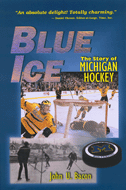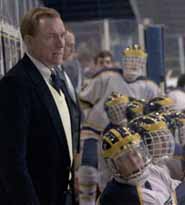Michigan's Winged Helmet -- Hockey Version
The New Look Wolverines
[From Blue Ice: The Story of Michigan Hockey, by John U. Bacon]
The Michigan hockey team has gone through almost as many helmet designs as head coaches. The team went hatless in the 1920s, then strapped on leather bowls for the next two decades before switching to plastic boxes, synthetic domes, CCMs, Coopers, and finally Nikes. But the most dramatic change in headgear occurred on an otherwise uneventful day in late February 1989.
Former captain Alex Roberts remembers it like it was yesterday. "Right before the league playoffs, we're coming up the stairs to the locker room" he recounts, "and we start smelling fresh paint. The smell's everywhere. "We get up to the top of the stairs and see the training room tables in the hallway, with a bunch of helmets on 'em painted dark blue with the yellow wings, just like the football team's—and we literally thought it was a joke. The helmets were to out of the normal protocol. We're like, 'Where are our real helmets, the white ones? What the hell are these? We were laughing our asses off. Then Red comes in and says, 'You guys are wearing these.'
"That night we bought Red one of those baseball caps with the football helmet design on it and gave it to him the next day.
'If we're gonna wear these things on our heads,' you are too.' He did."
Paul Gallagher, an Ann Arbor attorney and Michigan hockey fan, gave Berenson the idea to borrow the famed design, which definitely was not an immediate hit with the hockey players.
"Funny thing was," Roberts adds, "we had all gotten buzz cuts that week for team unity before the playoffs. And now we all had to readjust our helmets to fit our smaller heads, which meant the yellow stripes were all out of whack."
But the design got the attention it was supposed to get. When the Wolverines came out for warm ups against Bowling Green to open their best of three playoff series, the Falcons actually stopped what they were doing to gawk at the Michigan team's new look. "We just said, 'Hey man, this is us,"' Roberts recalls, chuckling. "We've gotta do what we're told. 'All I can say is, we felt pretty corny."
Berenson's hockey players might have been more shocked at their first sighting of the unorthodox design than Fritz Crisler's football players were a half century earlier.
Fritz Crisler won a national championship in 1947, he changed the game forever with the platoon system in the late 1940s, and he shaped college football by serving on the NCAA rules committee for over two decades before he retired in 1968. Yet the former Michigan football coach and athletic director might be best remembered for designing Michigan's distinctive "winged helmet," still the most recognizable headgear in college football.
[…]
No matter the origins, there is no question that the unique helmet has been Michigan's calling card for six decades. Michigan's football coaches can't count how many times they've heard recruits say that it was the first thing they liked about Michigan. Some players have even said their desire to wear the famous winged helmet was their primary motive to come to Ann Arbor, including Michigan's long time rushing leader Jamie Morris.
"I had three older brothers play for Syracuse [including Joe, who later starred for the New York Giants], but I just loved Michigan's helmets," he says. "that's the reason why I came here—that and the little guy storming up and down the sidelines," he adds, referring to his coach, Bo Schembechler.
Michigan's opponents aren't quite as fond of it. When the Wolverines gather under the tunnel before games, the maize strips on their dark helmets give them the appearance of a bunch of bees from the stands, ready to attack anything in their path—an effect that's amplified when they charge through the "M Go Blue" banner and jump on top of each other at the far end of the field. Any opposing player can tell you that is one of the scariest sights in college football—so much so some visiting coaches won't even let their players watch. Several Michigan opponents, including Notre Dame and Indiana, have taken to taping the design over their helmets during practice to lessen the shock of seeing the maize and blue helmets come flying out of the tunnel and set up across the line.
But that's not the same as the real thing. The design has come to symbolize so much power, discipline, excellence that after the Wolverine hockey team adopted it, the swimming and baseball teams did, too. The look seems to help the hockey coaches recruit almost as much as it does the football coaches. Keep in mind, virtually every Michigan hockey recruit sees Michigan's football team on TV before they see the hockey team, and the helmet always makes an impression.
What seemed so foreign at first now seems completely natural. "When I look back at photos of our plain white helmets," Roberts says, "it just doesn't look right. Everybody loves the winged helmets."
Over the past decade, the unique design has become a symbol closely linked with the hockey team's excellence, too. The team has never had a losing record wearing Crisler's design, earning 11 consecutive NCAA bids and two national crowns since switching over. Other hockey teams are learning to loathe the helmets almost as much as Michigan*s football foes do.
"Everybody else has got regular helmets," says Bobby Hayes, class of '98. "No one else has helmets like we do. That helmet, that's Michigan."



